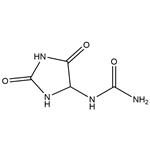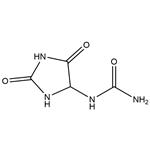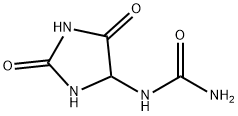Allantoin: A Comprehensive Overview
Introduction
Allantoin is a prominent compound in the field of chemistry, known for its extensive applications in pharmaceuticals, cosmetics, and personal care products. This versatile compound has garnered significant attention due to its beneficial properties and wide range of uses. With its ability to promote cell regeneration, soothe irritation, and provide moisturizing effects, allantoin plays a crucial role in enhancing the efficacy of various formulations. This article aims to provide an in-depth understanding of allantoin, focusing on its properties, composition, uses, and storage methods.

Figure 1 Characteristics of Allantoin
Properties of Allantoin
Allantoin (C4H6N4O3) is a diureide of glyoxylic acid, featuring a white, odorless crystalline powder form. This compound is recognized for its high stability under normal conditions, solubility in boiling water, slight solubility in cold water, and insolubility in most organic solvents.
The molecular weight of allantoin is 158.12 g/mol, and it melts at temperatures ranging from 230°C to 240°C. In aqueous solutions, allantoin exhibits a pH ranging from 4.0 to 6.0, indicating mild acidity. Its keratolytic, moisturizing, and soothing properties make it a valuable ingredient in dermatological formulations, enhancing cell proliferation and promoting tissue regeneration.
Composition of Allantoin
Allantoin is composed of carbon, hydrogen, nitrogen, and oxygen atoms, arranged in a specific structure that facilitates its biological functions. The chemical formula, C4H6N4O3, highlights the presence of four carbon atoms, six hydrogen atoms, four nitrogen atoms, and three oxygen atoms.
Synthetically, allantoin can be produced through the oxidation of uric acid or by reacting glyoxylic acid with urea. Naturally, it is found in various plants and animal tissues, notably in the comfrey plant (Symphytum officinale), which has been used traditionally for its wound-healing properties.
Uses of Allantoin
The versatility of allantoin is evident in its wide array of applications across different industries.
Pharmaceutical Applications: Allantoin is highly valued in the medical field for its wound healing and tissue regeneration capabilities. It is commonly used in topical treatments for skin conditions such as ulcers, burns, and abrasions. By promoting cell proliferation, allantoin accelerates the healing process. Additionally, it is incorporated into oral care products to soothe and protect mucous membranes.
Cosmetic and Personal Care: In the cosmetic industry, allantoin is a popular ingredient due to its moisturizing and keratolytic effects. It softens and protects the skin, encourages cell turnover, and reduces irritation and inflammation. Allantoin is found in various products, including creams, lotions, shampoos, and anti-aging treatments, particularly for sensitive skin formulations.
Agricultural Use: Allantoin is utilized in agriculture to stimulate plant growth, enhance root development, and improve nutrient uptake. It is included in fertilizers and soil conditioners to boost crop yield and quality.
Industrial Applications: In industrial settings, allantoin is used in the production of certain polymers and plastics. It acts as a stabilizer, enhancing the durability and performance of the final products.
Storage Methods for Allantoin
To ensure the stability and efficacy of allantoin, proper storage is essential. The following guidelines are recommended:
Temperature: Store allantoin at room temperature, ideally between 15°C and 25°C. Avoid exposure to direct sunlight and heat sources to prevent degradation.
Humidity: As allantoin is hygroscopic, it should be kept in a tightly sealed container to protect it from moisture.
Container: Use airtight, light-resistant containers for storage. Glass or high-density polyethylene (HDPE) containers are preferred to prevent reactions with the storage material.
Handling: Handle allantoin with care, using appropriate protective equipment to avoid inhalation or skin contact. Clean any spills immediately to prevent contamination.
Conclusion
Allantoin is a remarkable compound with diverse applications, particularly in the pharmaceutical and cosmetic industries. Its properties, including cell regeneration, moisturizing, and soothing effects, make it a valuable ingredient in various products. Proper storage and handling are crucial to maintain its effectiveness. As research continues, the importance of allantoin in chemical and medical industries is expected to increase, paving the way for innovations and applications.
![Article illustration]() Reference
Reference
[1] Shestopalov A V, Shkurat T P, Mikashinovich Z I, et al. Biological functions of allantoin[J]. Biology Bulletin, 2006, 33: 437-440.
[2] Araújo L U, Grabe-Guimar?es A, Mosqueira V C F, et al. Profile of wound healing process induced by allantoin[J]. Acta Cirurgica Brasileira, 2010, 25: 460-461.
);See also
Lastest Price from Allantoin manufacturers

US $0.00-0.00/kg2024-09-19
- CAS:
- 97-59-6
- Min. Order:
- 0.10000000149011612kg
- Purity:
- ≥99%
- Supply Ability:
- 20tons

US $0.00-0.00/kg2024-09-19
- CAS:
- 97-59-6
- Min. Order:
- 0.10000000149011612kg
- Purity:
- ≥99%
- Supply Ability:
- 20tons


